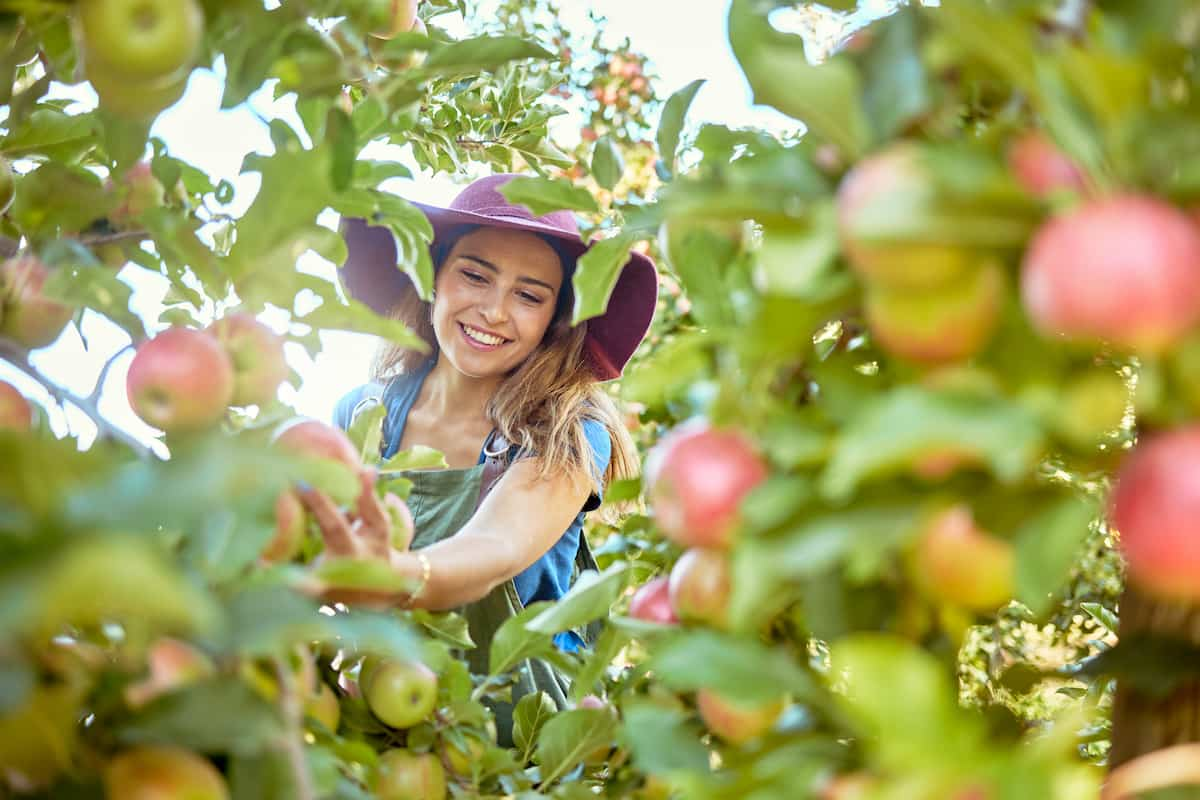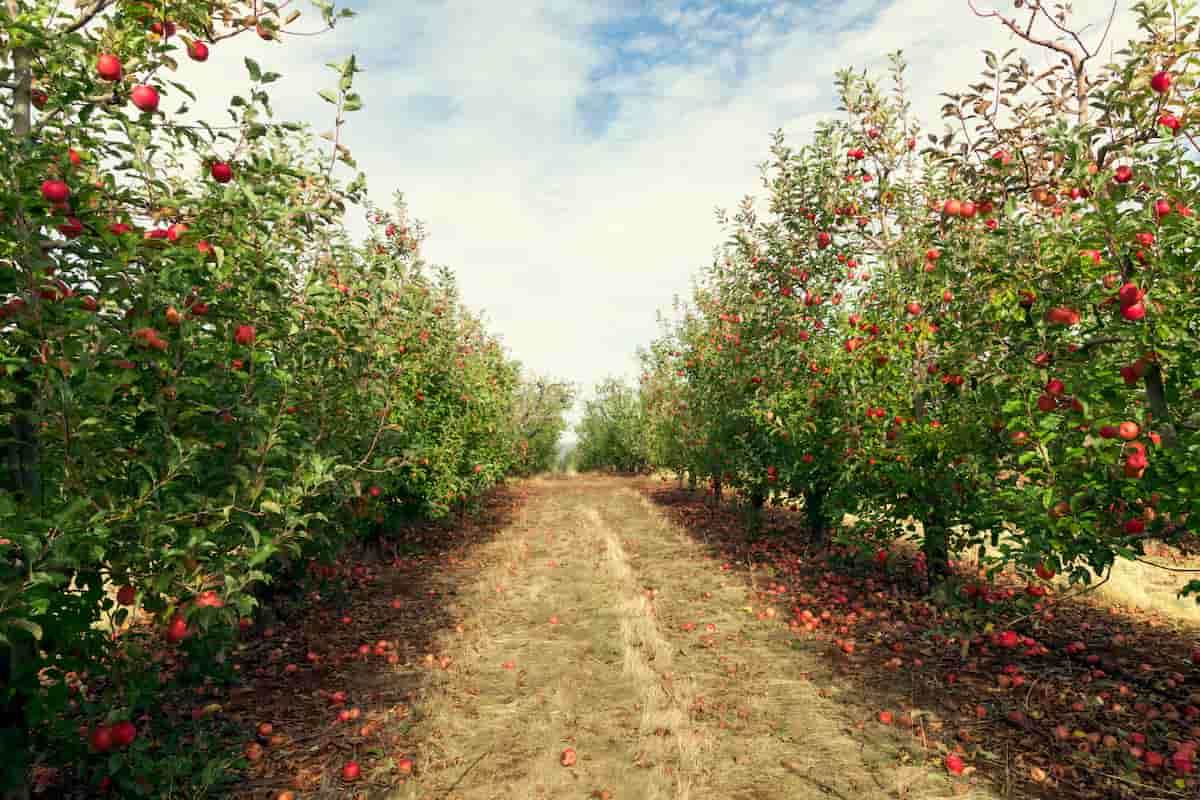Commercially, apples are one of the most important temperate fruits. Following bananas, oranges, and grapes, it is the fourth most widely produced fruit worldwide. Many pests are attracted to apples (Malus), which makes organically growing them difficult. The results and types of pests attacking your tree can vary yearly, and pest control tactics can be labor-intensive.

Nevertheless, it would be best if you didn’t let this discourage you since organic farming is healthy for the environment and your health. Apple tree pests are typically managed organically by releasing beneficial insects and spraying organically approved insecticides. To better understand organic apple cultivation, let’s take a closer look at it.
How to Grow Apples Organically
Soil and Spacing Requirements While Planting Apple Tree
Loam soils with a pH range of 5.5-6.5 and a depth of 45 cm are best for apple growth. There should not be any hard substrata or waterlogged conditions in the soil. Soil with a heavy clay content or compact subsoil should be avoided. Planting apple trees at different distances depends on the variety. Apple trees need to be spaced out as follows:
- Dwarf: 8 to 10 feet
- Semi-Dwarf: 12 to 15 feet
- Standard: 18 to 20 feet
- Columnar: 2 to 3 feet
How to Plant an Apple Tree
- Let the apple tree’s roots soak in water for 1 to 2 hours.
- Select a site that receives full sun and dig a hole there. Roots need plenty of room to spread and grow, so the hole should be deep and wide.
- Place the apple tree’s roots down and spread them out in the center of the planting hole.
- Hold the trunk vertically, then fill the hole back up.
- A rim of soil should be created around the planting hole about three inches above ground level. Water is caught in this berm and soaked in rather than drained off, causing soil erosion.
- Protect the apple tree’s trunk with two to three inches of mulch.
Apple Tree Growth Stages
Like other deciduous fruit trees, the apple tree grows in a series of stages each year. These growth stages are critical to treating fungal diseases and pests on apple trees effectively. Apple trees typically grow in the following stages:
- Dormancy: At this stage, apple trees are dormant and have little activity.
- Silvertip: Light gray or silver tissue is exposed at the tip of the fruit bud when the scales are separated.
- Green tip: Green tissue is visible in about 1/16-inch of buds that have been broken at the tip
- Half-inch green: 1/2 inch of green leaf tissue emerges from their fruit buds.
- Tight cluster: Generally, the blossom buds are exposed and grouped tightly, with short stems.
- Pink or open cluster: In the blossom cluster, all buds are pink and have long stems.
- Bloom: From the opening of the first bloom in each cluster to full bloom (all or most blossom buds are open.)
- Post bloom: It is when 75% of petals have fallen.
In case you missed it: How to Start a Fruits and Vegetables Export in India: A Profitable Agriculture Business

Apple Tree Care
Watering for Apple Tree
Apple trees that are newly planted need to be watered weekly. It would be necessary to provide more water to newly planted trees than mature ones. An adequate amount of water is approximately 5 gallons (one large bucket) per week. Allow it to soak into the soil slowly for deep watering until the plant is established. In the absence of prolonged dry periods, apple trees require infrequent watering once they are established. Water the tree when the top eight to ten inches of soil are dry. Every seven to ten days, it is sufficient to receive about an inch of rainfall.
Organic Feeding for Apple Tree
Each year, apple trees grow 8 to 12 inches. Supplemental fertilizers aren’t really necessary for them. Mulch the tree’s base liberally with aged compost once or twice a year after the leaves have fallen. The most effective fertilizer for apple trees is high-nitrogen fertilizer. Chicken manure, blood, soybeans, cottonseed, and feathers are excellent organic nitrogen sources. Apple trees need organic fertilizers to grow healthy apples and grow stronger over the years.
Thinning Apples on Apple Tree
Ensure apple trees are well-established before fruiting. It is important to handpick the flowers and young fruit during the first two years of the plant’s life. As a result, the tree will have more energy to establish its roots in place of producing fruit. A small crop can be allowed in the third year, but the fruit should be thinned to ensure quality and size.
Thin fruit as early as possible as before each apple reaches the size of a dime in diameter. This usually occurs within the first 20 days after the petal fall. Removing these small fruits early will keep energy available for the fruit that remains and for fruit bud development next year.
Pruning Apple Tree
Pruning apple trees is beneficial. Pruning allows an apple tree to get light and air. Pruning should be done every year. A tree should not be pruned over one-third of its total height in one growing season. Pruning is best done in late winter when the tree is dormant and before its buds appear. To prune an apple tree, follow these steps:
- All diseased, dead, or broken branches should be removed.
- Remove all water sprouts, which usually grow vertically without any side branches.
- Ensure all suckers, the roots that grow out of the soil, are removed.
- Remove branches with tight V-branching crotches that cannot support the weight of a full crop of fruits.
- Remove branches that cross or rub each other. Branches may cross or rub when they intersect.
Organic Mulching an Apple Tree
Mulching an apple tree can improve soil structure, retain moisture, and increase soil fertility. However, many people fail to properly follow the basic steps for mulching an apple tree. The base of an apple tree should be mulched with 4-6 inches of wood chips around the outer edge, tapering down to a depth of 1 inch at the base of the trunk. Create a berm or donut around the outer edge and seed it with 4-6 inches of wood chips.
In case you missed it: How to Start a Guar Gum Manufacturing in India: A Profitable Agriculture Business

Organic Pest Control in Apple Tree
- The coddling moth can be controlled using sprays containing paraffinic oil, kaolin clay, or Spinosad. You should pick up and dispose of dropped fruit and remove all infested apples by hand before the larvae emerge.
- One or two red, spherical, sticky traps specifically formulated for apple maggots can be used to manage apple maggots. Diatomaceous earth, pyrethrum products, and rotenone are other organic methods for controlling apple maggots in home orchards.
- Paraffinic oil, also known as horticultural oil and dormant spray oil, smothers and kills overwintering eggs of many apple tree pests. This treatment is effective against scale insects, red bugs, European red mites, bud moths, leaf rollers, apple aphids, and codling moth larvae.
Conclusion
Apple is the highest consuming fruit than other fruits as it is healthy and tasty. It is also considered the most profitable fruit crop because of its high consumption and medicinal value. The fruit requires a considerable period of dormancy, well-drained soil, careful pruning, and a rigorous pest-management program for good growth.
- Feed Your Flock for Less: Top 10 Tips to Save on Chicken Feed
- Ultimate Guide to Ossabaw Island Hog: Breeding, Raising, Diet, and Care
- Hatching Answers: The Top 10 Reasons Your Chickens Aren’t Laying Eggs
- Eggs and Economics: Breaking Down the Cost of Raising Backyard Chickens
- Defend Your Greens: Proven Methods to Keep Iguanas Out of Your Garden
- Ultimate Guide to Cinnamon Queen Chicken: A Comprehensive Guide for Beginners
- Ultimate Guide to California Tan Chicken: Breeding, Raising, Diet, Egg-Production and Care
- Ultimate Guide to Marsh Daisy Chicken: Breeding, Raising, Diet, and Care
- 10 Types of Chicken Farming Businesses You Can Start for Profits